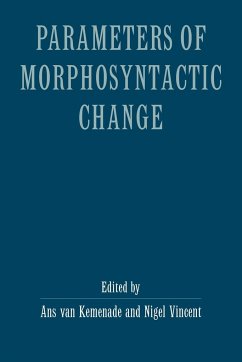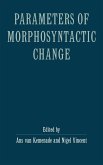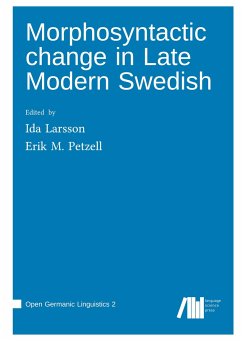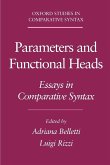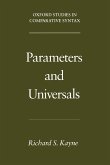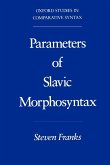- Broschiertes Buch
- Merkliste
- Auf die Merkliste
- Bewerten Bewerten
- Teilen
- Produkt teilen
- Produkterinnerung
- Produkterinnerung
This volume of essays addresses the issues of syntactic and morphological change.
Andere Kunden interessierten sich auch für
![Parameters Morphosyntactic Change Parameters Morphosyntactic Change]() Ans van van Kemenade (eds.) / Nigel Vincent (eds.)Parameters Morphosyntactic Change133,99 €
Ans van van Kemenade (eds.) / Nigel Vincent (eds.)Parameters Morphosyntactic Change133,99 €![Morphosyntactic Change Morphosyntactic Change]() Bettelou LosMorphosyntactic Change108,99 €
Bettelou LosMorphosyntactic Change108,99 €![Morphosyntactic Change Morphosyntactic Change]() Bettelou LosMorphosyntactic Change41,99 €
Bettelou LosMorphosyntactic Change41,99 €![Morphosyntactic change in Late Modern Swedish Morphosyntactic change in Late Modern Swedish]() Morphosyntactic change in Late Modern Swedish40,00 €
Morphosyntactic change in Late Modern Swedish40,00 €![Parameters and Functional Heads Parameters and Functional Heads]() Rizzi BellettiParameters and Functional Heads72,99 €
Rizzi BellettiParameters and Functional Heads72,99 €![Parameters and Universals Parameters and Universals]() Richard S. KayneParameters and Universals102,99 €
Richard S. KayneParameters and Universals102,99 €![Parameters of Slavic Morphosyntax Parameters of Slavic Morphosyntax]() Steven FranksParameters of Slavic Morphosyntax161,99 €
Steven FranksParameters of Slavic Morphosyntax161,99 €-
-
-
This volume of essays addresses the issues of syntactic and morphological change.
Hinweis: Dieser Artikel kann nur an eine deutsche Lieferadresse ausgeliefert werden.
Hinweis: Dieser Artikel kann nur an eine deutsche Lieferadresse ausgeliefert werden.
Produktdetails
- Produktdetails
- Verlag: Cambridge University Press
- Seitenzahl: 558
- Erscheinungstermin: 19. Mai 2011
- Englisch
- Abmessung: 229mm x 152mm x 30mm
- Gewicht: 798g
- ISBN-13: 9780521586436
- ISBN-10: 0521586437
- Artikelnr.: 21846063
- Herstellerkennzeichnung
- Libri GmbH
- Europaallee 1
- 36244 Bad Hersfeld
- gpsr@libri.de
- Verlag: Cambridge University Press
- Seitenzahl: 558
- Erscheinungstermin: 19. Mai 2011
- Englisch
- Abmessung: 229mm x 152mm x 30mm
- Gewicht: 798g
- ISBN-13: 9780521586436
- ISBN-10: 0521586437
- Artikelnr.: 21846063
- Herstellerkennzeichnung
- Libri GmbH
- Europaallee 1
- 36244 Bad Hersfeld
- gpsr@libri.de
Introduction: parameters and morphosyntactic change Ans van Kemenade and
Nigel Vincent; Part I. Aspect, Argument Structure and Case Selection: 1.
The interdependence of case, aspect and referentiality in the history of
German Werner Abraham; 2. The rise of the article in the Germanic languages
Julia Philippi; 3. The diachronic development of a modal verb of necessity
Paola BenincÀ and Cecilia Poletto; 4. Auxiliary verbs in Old and Middle
French Philip H. Miller; 5. Commentary on part I: aspect, argument
structure and case selection Alessandra Tomaselli; Part II. Clitics: 6. The
emergence of the D-system in Romance Nigel Vincent; 7. On two locations for
complement clitic pronouns Maria Luisa Rivero; 8. On the integration of
second position phenomena Josep M. Fontana; Part III. Verb Second and Comp:
9. Shifting triggers and diachronic reanalyses David Lightfoot; 10. Viewing
change in progress Alison Henry; 11. Verb movement in Old and Middle
English Anthony Kroch and Ann Taylor; 12. V2 and embedded topicalization in
Old and Middle English Ans van Kemenade; 13. Qu'est-ce que ce que: the
diachronic evolution of a French complementizer Laurie Zaring and Paul
Hirschbühler; 14. The structure of parametric change, and V-movement in the
history of English Anthony Warner; Part IV. Scrambling and Morphological
Change: 15. Directionality and word order change in the history of English
Ian Roberts; 16. On the relation between morphological and syntactic case
Fred Weerman; 17. The rise of positional licensing Paul Kiparsky; The
papers by Kiparsky, Roberts and Weerman: an epilogue Höskuldur Thrainsson;
References; Index.
Nigel Vincent; Part I. Aspect, Argument Structure and Case Selection: 1.
The interdependence of case, aspect and referentiality in the history of
German Werner Abraham; 2. The rise of the article in the Germanic languages
Julia Philippi; 3. The diachronic development of a modal verb of necessity
Paola BenincÀ and Cecilia Poletto; 4. Auxiliary verbs in Old and Middle
French Philip H. Miller; 5. Commentary on part I: aspect, argument
structure and case selection Alessandra Tomaselli; Part II. Clitics: 6. The
emergence of the D-system in Romance Nigel Vincent; 7. On two locations for
complement clitic pronouns Maria Luisa Rivero; 8. On the integration of
second position phenomena Josep M. Fontana; Part III. Verb Second and Comp:
9. Shifting triggers and diachronic reanalyses David Lightfoot; 10. Viewing
change in progress Alison Henry; 11. Verb movement in Old and Middle
English Anthony Kroch and Ann Taylor; 12. V2 and embedded topicalization in
Old and Middle English Ans van Kemenade; 13. Qu'est-ce que ce que: the
diachronic evolution of a French complementizer Laurie Zaring and Paul
Hirschbühler; 14. The structure of parametric change, and V-movement in the
history of English Anthony Warner; Part IV. Scrambling and Morphological
Change: 15. Directionality and word order change in the history of English
Ian Roberts; 16. On the relation between morphological and syntactic case
Fred Weerman; 17. The rise of positional licensing Paul Kiparsky; The
papers by Kiparsky, Roberts and Weerman: an epilogue Höskuldur Thrainsson;
References; Index.
Introduction: parameters and morphosyntactic change Ans van Kemenade and
Nigel Vincent; Part I. Aspect, Argument Structure and Case Selection: 1.
The interdependence of case, aspect and referentiality in the history of
German Werner Abraham; 2. The rise of the article in the Germanic languages
Julia Philippi; 3. The diachronic development of a modal verb of necessity
Paola BenincÀ and Cecilia Poletto; 4. Auxiliary verbs in Old and Middle
French Philip H. Miller; 5. Commentary on part I: aspect, argument
structure and case selection Alessandra Tomaselli; Part II. Clitics: 6. The
emergence of the D-system in Romance Nigel Vincent; 7. On two locations for
complement clitic pronouns Maria Luisa Rivero; 8. On the integration of
second position phenomena Josep M. Fontana; Part III. Verb Second and Comp:
9. Shifting triggers and diachronic reanalyses David Lightfoot; 10. Viewing
change in progress Alison Henry; 11. Verb movement in Old and Middle
English Anthony Kroch and Ann Taylor; 12. V2 and embedded topicalization in
Old and Middle English Ans van Kemenade; 13. Qu'est-ce que ce que: the
diachronic evolution of a French complementizer Laurie Zaring and Paul
Hirschbühler; 14. The structure of parametric change, and V-movement in the
history of English Anthony Warner; Part IV. Scrambling and Morphological
Change: 15. Directionality and word order change in the history of English
Ian Roberts; 16. On the relation between morphological and syntactic case
Fred Weerman; 17. The rise of positional licensing Paul Kiparsky; The
papers by Kiparsky, Roberts and Weerman: an epilogue Höskuldur Thrainsson;
References; Index.
Nigel Vincent; Part I. Aspect, Argument Structure and Case Selection: 1.
The interdependence of case, aspect and referentiality in the history of
German Werner Abraham; 2. The rise of the article in the Germanic languages
Julia Philippi; 3. The diachronic development of a modal verb of necessity
Paola BenincÀ and Cecilia Poletto; 4. Auxiliary verbs in Old and Middle
French Philip H. Miller; 5. Commentary on part I: aspect, argument
structure and case selection Alessandra Tomaselli; Part II. Clitics: 6. The
emergence of the D-system in Romance Nigel Vincent; 7. On two locations for
complement clitic pronouns Maria Luisa Rivero; 8. On the integration of
second position phenomena Josep M. Fontana; Part III. Verb Second and Comp:
9. Shifting triggers and diachronic reanalyses David Lightfoot; 10. Viewing
change in progress Alison Henry; 11. Verb movement in Old and Middle
English Anthony Kroch and Ann Taylor; 12. V2 and embedded topicalization in
Old and Middle English Ans van Kemenade; 13. Qu'est-ce que ce que: the
diachronic evolution of a French complementizer Laurie Zaring and Paul
Hirschbühler; 14. The structure of parametric change, and V-movement in the
history of English Anthony Warner; Part IV. Scrambling and Morphological
Change: 15. Directionality and word order change in the history of English
Ian Roberts; 16. On the relation between morphological and syntactic case
Fred Weerman; 17. The rise of positional licensing Paul Kiparsky; The
papers by Kiparsky, Roberts and Weerman: an epilogue Höskuldur Thrainsson;
References; Index.

